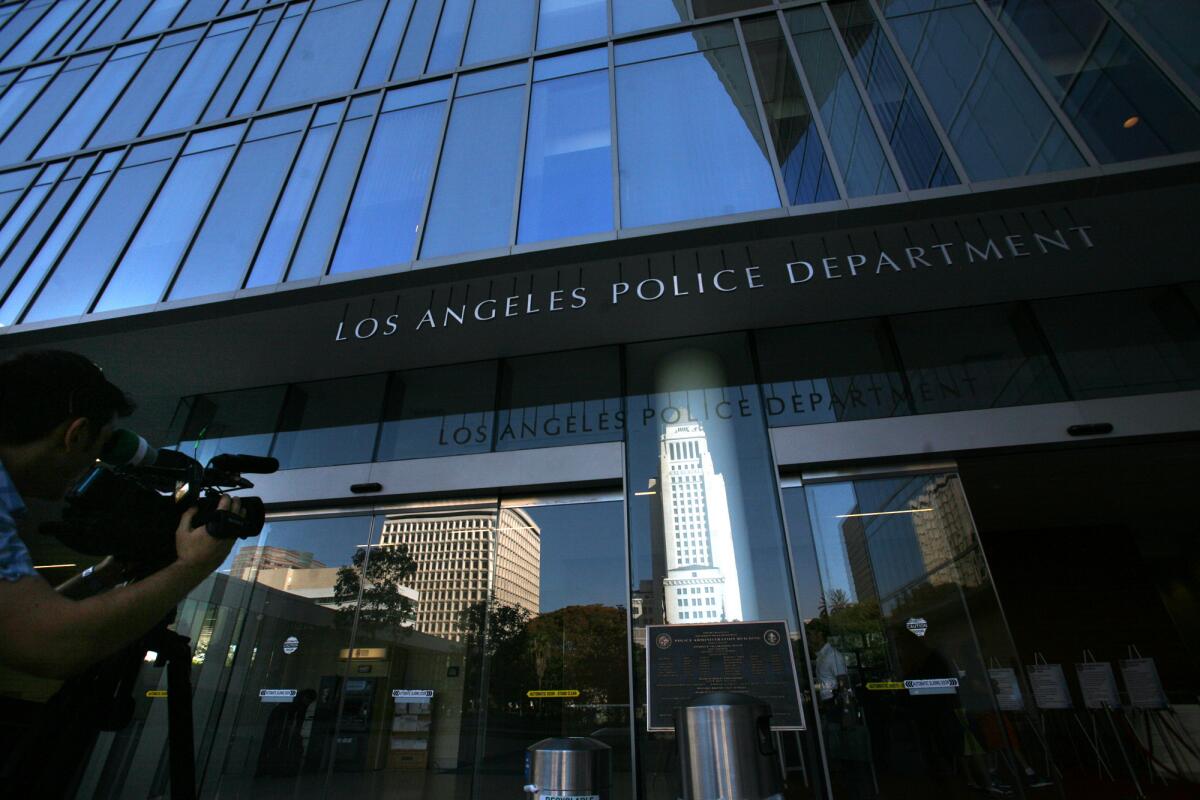LAPD youth diversion program under review as advocates, commissioners cite shortcomings

The Los Angeles Police Department’s system for diverting kids who are detained for crimes into support programs, rather than courts and jail cells, came under fire during a Tuesday meeting of the civilian Police Commission, with youth advocates highlighting problems and commissioners promising reforms.
A major concern is that only a small percentage of the kids who are eligible for diversion under state guidelines are being provided the opportunity, even though community groups that offer services say they have the capacity to serve them.
“The programs are in place, the programs are healthy and robust and comprehensive, yet law enforcement still is not using the programs,” said Kim McGill of the Youth Justice Coalition.
LAPD Chief Michel Moore and other police officials promised to collaborate with the groups and the commission to improve the program but stopped short of accepting a major recommendation from the advocacy groups: that the LAPD stop operating its program altogether and instead allow kids detained in the city to go into a parallel L.A. County diversion program in which advocates have more trust.
Arrests of juveniles by the LAPD have plummeted in recent years, in part because of the diversion program. Started in 2013 in one small area of the city, it allows kids who have allegedly committed lesser crimes to avoid arrest and instead be diverted into community programs where they are mentored, taught to process their emotions and introduced to hobbies — from slam poetry to boxing to gardening.
In recent years, the program has been expanded to every part of the city. Police officials say it is a success and is a major part of their approach to juvenile crime.
However, LAPD data shared with The Times show that a majority of kids who are detained by the LAPD and are eligible for diversion don’t receive it and instead get arrested and booked into the criminal justice system.
Of 4,278 kids who were recently arrested, 2,592 — about 61% — were eligible for diversion under state guidelines, according to the data. However, only 789 — just over 30% — were actually diverted.
During the meeting Tuesday, advocates of the program and Commissioner Shane Murphy Goldsmith asked why the department had decided to exclude kids.
Police officials said kids who are technically eligible for diversion based on the crimes they are alleged to have committed may be excluded from the program because they have a prior criminal record, because they have alleged gang ties or because they or their parents declined to participate in diversion.
Police officials said the decisions are made by watch commanders and LAPD juvenile coordinators in the areas where the kids have been detained, but also that the criteria for possible exclusion from the program were established in consultation with prosecutors in the district attorney’s office.
Advocates — including members of the Youth Justice Coalition and several diversion providers — said the city’s exclusion criteria were inappropriate and far stricter than those employed by L.A. County’s Youth Diversion and Development program. They also said excluding kids with records or gang ties from diversion programs makes no sense, because those are the kids who need the services the most.
Among other demands, the advocates called on the LAPD to redirect all diversions to the county, provide community organizations with real-time data on youth arrests and other data relevant to the tracking of youth diversion in the city and reconfigure its responses to situations involving kids to ensure that a team of counselors and others with experience in the youth diversion system get dispatched to scenes.
Several young people joined the call and spoke to the value of diversion in their lives. Xcellen Connor said a diversion program taught him to process his thoughts and dive deeper into becoming a writer.
“You can feel the love,” he said of being in a program. “It was such an amazing, enlightening experience.”
Police could not provide reasons for all of the exclusions in recent years, citing a failure in data collection that they said they are now fixing.
Goldsmith said she wants to see 100% of eligible kids be diverted rather than arrested and specifically challenged the use of gang affiliation as a criterion for exclusion, given recent evidence that “the way that young people are characterized as gang members is deeply flawed.”
This year, criminal charges were filed against three LAPD officers for allegedly mislabeling people as gang members, and the department halted its use of the statewide CalGang database, citing problems with accurately identifying alleged gang members and affiliates.
Goldsmith said LAPD data have shown racial disparities in juvenile arrests in recent years — including an increase in the proportion of juvenile arrests involving Black kids, even as overall juvenile arrests declined. Any review of the diversion program must include a look at how the program confronts or adds to structural racism, she said.
Commission President Eileen Decker said there was “a lot of work to be done” and appointed Goldsmith and Commissioner Lou Calanche to an ad hoc subcommittee to look into issues with the LAPD’s current program and report back to the full commission with ideas for improving it.
Moore said he looks forward to building an improved program that serves all parties — including victims of crime — and is reliable whenever kids come into contact with police, even if that is at 3 a.m.
Anne Tremblay, director of gang reduction and youth development in Mayor Eric Garcetti’s office, said her team is facilitating diversion in some parts of the city with the help of state grant funding and, moving forward, will coordinate with the county and the LAPD to ensure robust oversight and broad-access diversion programming for kids citywide.
More to Read
Sign up for Essential California
The most important California stories and recommendations in your inbox every morning.
You may occasionally receive promotional content from the Los Angeles Times.











